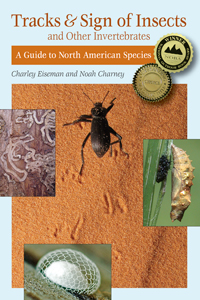Back in July, I shared an assortment of moth photos I’d taken during a week on Nantucket, which happened to be National Moth Week. I included this photo of a row of flat, overlapping eggs on a woolly bulrush (Scirpus cyperinus) leaf in a marsh.
As I mentioned, this was one of three similar rows of eggs on the same leaf:
I collected the leaf in the hope of raising the larvae to learn what they were. A week later, some tiny, bright red caterpillars had hatched.
Unfortunately, they weren’t interested in eating bulrush leaves or anything else I offered them. Seeing that they were all dying, I salvaged one to include in my shipment to the Netherlands of specimens for DNA barcoding. The other day Erik van Nieukerken informed me that barcoding had identified it as Epina alleni (Crambidae), which looks like this as an adult:
Apparently nothing is known of the immature stages or host plant(s) of this moth. According to the HOSTS database, the other species in this genus, E. dichromella, has been recorded as feeding on rice in Sri Lanka. This is odd, since Wikipedia only mentions that species as occurring in the southeastern US and Cuba. I’ve grown accustomed to finding outright lies in the HOSTS database, and in glancing at the list of North American crambid moths on the Moth Photographers Group website, I found a likely explanation:
| 5468 | Epina dichromella | |
| 5469 | Epina alleni | |
| 5470 | Chilo plejadellus | Rice Stalk Borer Moth |
The rice stalk borer moth (Chilo plejadellus) is listed just after the Epina species, and it does occur in Sri Lanka. My guess is that whoever added that record to the database accidentally attributed the host record to Epina dichromella because the two species were listed next to each other in whatever reference they were using. I have found clear cases of this same error before, when I had access to the book version of the HOSTS database, which cites all the sources of the host records (except, maddeningly, many of the most questionable host records are attributed to reference #492, which is missing from the bibliography).
So, as far as I can tell, no one knows what the larvae of either Epina species do, but at least now we know what their eggs (and first instars) look like. Since they are closely related to the rice stalk borer, it may be that they bore in the stems of bulrushes. If I remember correctly, this bulrush was in standing water, so it does seem like it was the intended host plant, unless the larvae are able to swim.








Love it!
Great sroty! link on NMW facebook and twitter. Liti
Interesting story! I noticed that you sent your sample to the Netherlands for DNA bar coding. I’ve been looking for a place to get some of that done. I hear that BOLD systems no longer accepts individual samples so I’m curious if the outfit you used in the Netherlands does so. My focus in on moths.
This was an unusual situation. Erik van Nieukerken at the Naturalis Biodiversity Center was willing to do me the favor of barcoding a few samples because I had collected a lot of material that he had requested. Unfortunately I have no idea how to go about getting individual samples barcoded, or who to approach about it, if you don’t have some kind of “in” like that.
A few barcoders have come across your post and asked me to help direct those that are interested to a new way that citizen scientists can get access to DNA Barcoding services. Recently, we (the team that developed BOLD) launched a new app called LifeScanner, for use on iPhones (and iPods or iPads that are equipped with a camera). This software can be used in conjunction with the LifeScanner DNA barcoding kit – which is a collection kit we will send you that allows you to collect and preserve samples for DNA barcoding. The kit contains 4 vials, and for the next while we are distributing trial kits for free – charging only for shipping costs.
This means that you can get DNA barcodes for 4 specimens without paying for the sequencing fees, as we are currently doing a trial run on the kits that we have developed. The mobile app on your phone allows you to collect all the information about the collection site, take photos, and record any information relevant about the collection or specimen, and everything is submitted to the lab via the app. When the DNA is sequenced and the identification is made, this information is sent back to your phone as well. Please check out http://www.lifescanner.net/ for more information and to sign up for a trial kit! Feel free to contact us if you have more questions as well!
Thanks for the info!
Thanks very much for the information! I will definitely check out the lifescanner website.